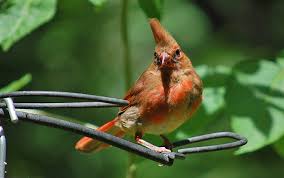But some baby birds are ubiquitous here in West Hartford at the end of July, and I get to see them close up on my deck. My favorite is the juvenile cardinal. Skinny, slight, and not fully colored, the juvenile cardinal, with its outsize crest, looks like an adolescent going through a punk phase.
 |
| Punk cardinal |
 |
| What are YOU lookin' at? |
The punk image is totally destroyed, though, when one of the cardinal parent appears. Then the baby sheds the punk insouciance and starts with the "feed me!" behavior, flapping its wings, peeping, and hopping along hopefully behind the parent.
Who's tough now?
 |
| Take a look at the wing-flapping behavior in the baby |
That spotted breast shows that the bird is a member of the thrush family. In robins, the spotted breast appears only in juveniles. By adulthood, it has become a tiny checkered patch at the base of the neck. Other thrushes, like the wood thrush and the hermit thrush, keep their spotted breasts all their lives.
Robin mystery: why is the bird's scientific name turdus migratorius? "Turdus" is the Latin word for ugly. Not a fair appellation for this bird, whose chimes woke me every summer morning of my childhood.
And how about the veery? That's one of my favorite thrushes, one that keeps the checkered breast. I diverge here because this post is about fledgling birds in my yard, and the truth is, there currently is no veery in my West Hartford yard.
But there used to be one whose ethereal call drifted down from the tall tree canopy when I lived on Whitney Street in Hartford. I divert for a moment because I want you to listen to that call, dropping airily in a crystal spiral: http://www.allaboutbirds.org/guide/Veery/sounds.
Back to my backyard birds: A couple of weeks ago I saw what must have been a juvenile mourning dove. It must have been, because it looked in every way like an adult, but it was smaller and skinnier. At first I thought,"Why is that mourning dove so skinny?" Then I realized: it must be a baby. But a baby without the juvenile awkwardness of the cardinal. This baby was all organized and arranged, every feather in place.
Nothing like the adolescent awkwardness of the fledgling cardinal.


















